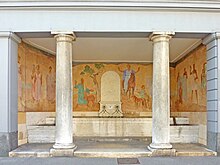Numa Donzé
Numa Donzé (born November 6, 1885 in Basel , † October 25, 1952 in Riehen ) was a Swiss painter .
life and work
Numa Donzé was the son of Charles Gustave Donzé (1838–1921), who was a native of Les Breuleux . His first marriage was to the widow Elisabeth Jetzier, born Klein. They had three children together. When his wife died in 1879, his father married Wilhelmine Klingele (1847–1917) who originally came from Fahrnau im Wiesental. Donzé grew up with his sister Valerie and three step-siblings at Steinengraben in Basel.
Donzé's talent for characters was recognized early on and encouraged by his parents. After completing compulsory schooling, he attended the trade school in Basel and took lessons from Fritz Schider and Rudolf Löw .
From 1904 to 1905 Donzé studied in Munich with Heinrich Knirr and then traveled to Rome with a German painter friend. In 1906, Donzé's masterpiece The Liberation was created . A very idiosyncratic interpretation of the Ritter Georg legend, in that he did not focus on the liberator, but on the liberated one.
Donzé's early work included, among other things, the Rhine and Provence landscapes, which already brought him attention at the age of twenty. During and after the First World War, Donzé formed the loose Basel artist group of dark-tone painters together with Otto Roos , Paul Basilius Barth , Jean-Jacques Lüscher , Heinrich Müller and Karl Dick . This group of artists, known as “Basel's generation of classical painters”, was a revolutionary discovery for those interested in art in Basel. The group achieved their breakthrough in 1907 with a joint exhibition at the Kunsthalle Basel. The artists fostered a friendly exchange with the Basel artist group Das neue Leben, founded in 1918, and with the “ Red-Blue ” artist group and had a decisive influence on the development of Basel painting from the turn of the century until the 1920s.

At the end of 1907 Donzé traveled to Paris, where he was enthusiastic about Gustave Courbet , Paul Cézanne and Paul Gauguin . He shared the studio with Jean-Jacques Lüscher in an old monastery in Montmartre and lived in Paris until 1910, interrupted by two stays in Provence.
From 1910 to 1915, important Alsatian canal and Rhine landscape pictures as well as large murals, including the mural Allegory of Life (self-portrait as a warrior with a bride, blessed by death) on the facade of the Basler Nationalzeitung, were created .
From 1914 Donzé was active as a border soldier for four years . From 1920 to 1930 he worked mainly as a commissioned artist. For example, from 1919 to 1922 he created the mural John the Baptist on behalf of the newly founded Art Credit Basel-Stadt . This represents excerpts from the life of John the Baptist and can be seen in the niche of the Spalenberg fountain.
In 1922 Donzé traveled to Algeria to Biskra with Paul Basilius Barth .

In 1926, Donzé created the grape harvest fresco for the facade of the rebels' guild on Freie Strasse in Basel. The guild house, built in 1897, was demolished in 1957 and is now a department store in its place. In 1930 Jean-Jacques Lüscher painted the group picture of the meeting of the Basel Art Credit Commission in which Donzé can also be seen . In 1932 Donzé took part in the 18th Venice Biennale . In 1919 and 1926 he exhibited in the Kunsthalle Basel and in 1936 a major retrospective followed. In 1954, works by Donzé and Carl Burckhardt were shown in a memorial exhibition at the Kunsthalle Basel . Another commemorative exhibition was held in Riehen in 1979. Donzé usually signed his pictures, but very rarely dated them. To the chagrin of his artist friends and admirers, Donzé destroyed many works throughout his life that did not meet his requirements.
Donzé lived from 1930 to 1952 with his sister Valerie Brunner-Donzé (1963) and her husband in Riehen . During this period he and he often traveled to Italy, Paris, Provence, the Balearic Islands in the Markgräflerland and in Ticino to San Nazzaro . Donzé has also painted many landscapes in the Basel area, which is known for its picturesque Jura landscape in the Upper Basel area .
Together with his long-time girlfriend Helene Jetzler (1895–1988), Donzé found his final resting place in the cemetery on the Hörnli . Donzé's obituary was held by his artist friend Jean-Jacques Lüscher.
Works (selection)
- 1930: Wall painting Basel with the Rhine, in the main hall, floor F in the ETH Zurich
- 1934: Mural The Winter, for the Dreirose School in Basel
- 1937: Fresco, hand and machine, for the sample fair in Basel
literature
- Hans Krattiger : Numa Donzé (1885–1952) , in: Jahrbuch z'Rieche 1979
- Agathe Straumann, Basel-Stadt Education Department. Numa Donzé. In: Art for Basel: 75 years of art credit Basel-Stadt. Art in public space. Schwabe Verlag, Basel 1974, ISBN 3-7965-0968-1 .
Web links
- Sibylle E. Burckhardt: Donzé, Numa. In: Sikart
- Numa Donzé In: Swissbib
- Numa Donzé In: Artnet
- Numa Donzé In: Mural.ch
- Numa Donzé In: Basel Art Credit Collection
- Lucas Lichtenhan: Numa Donzé In: Basler Stadtbuch , 1952
- Numa Donzé, group exhibition, Dunkel – Hell, a chapter Basler Kunst In: Galerie Müller, Basel, 2019
Individual evidence
- ^ Jean-Jacques Lüscher: Donzé, meeting of the Basel Art Credit Commission. 1930. Retrieved October 10, 2019 .
- ^ Jean-Jacques Lüscher: Obituary for Numa Donzé. Retrieved October 9, 2019 .
| personal data | |
|---|---|
| SURNAME | Donzé, Numa |
| BRIEF DESCRIPTION | Swiss painter |
| DATE OF BIRTH | November 6, 1885 |
| PLACE OF BIRTH | Basel |
| DATE OF DEATH | October 25, 1952 |
| Place of death | Riehen |
